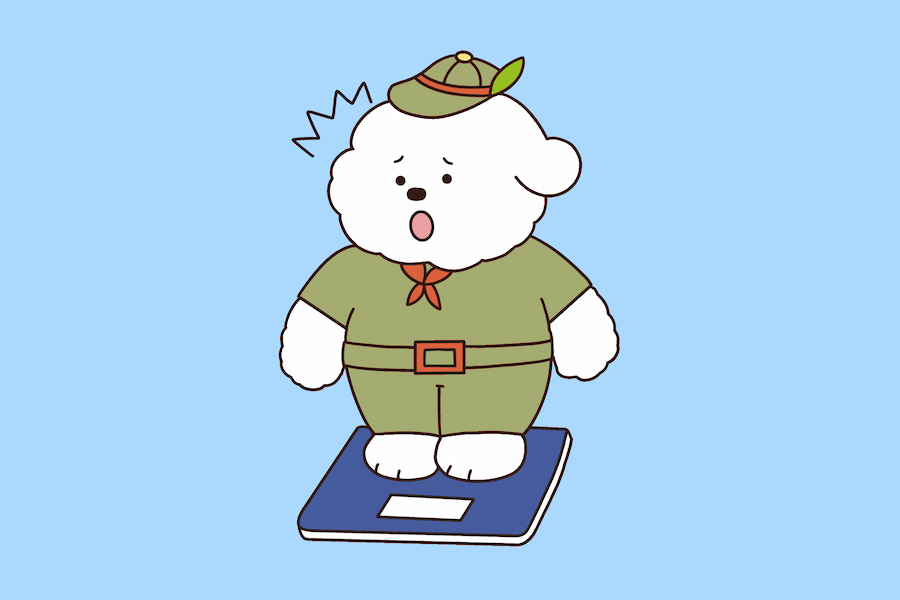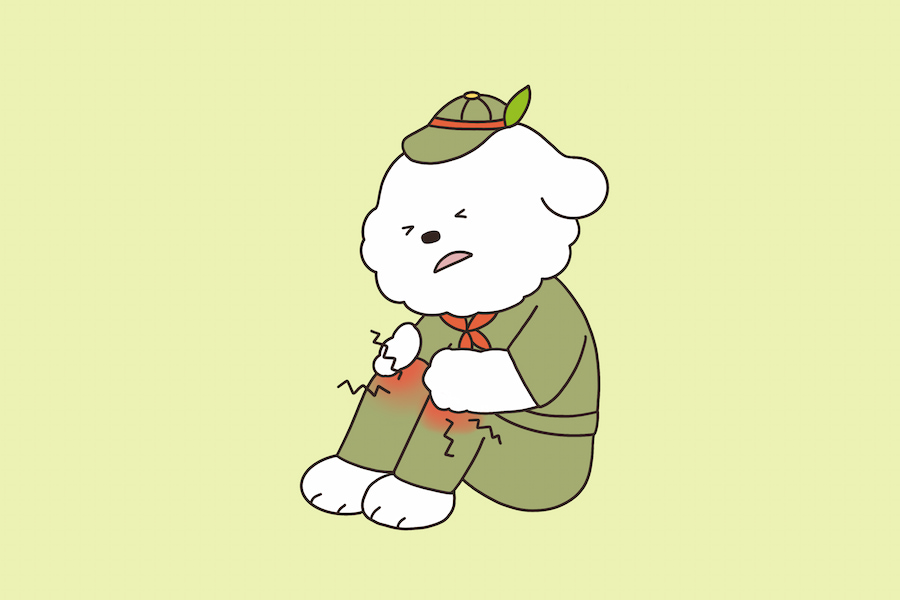Create a scenario in your mind. You are playing football with your dog, and everything seems perfect. Suddenly, your dog screams and holds up one of its back legs. You can clearly see your pet in discomfort. The dog might try to continue but can’t put weight on that leg. If you’re nearby, you might even hear some cracking sound, which can be concerning. It’s a moment that transforms the happy environment because it could mean your dog is experiencing a luxating patella.
Can you tell me the name of the most popular pet in the world? You are right! The loyal Dog!
In the world, 900 million people own dogs as pets. If you have a dog, it is obligatory to know about this orthopedic disease. This is a common joint issue in dogs.
This article will guide you about the signs, causes and treatment of this disease.

Dried pollock is the best treat for dogs with patellar luxation! At Lee&Pol, we thoroughly remove the salt and bones from dried pollock treats over 24 hours to provide the best treats for your dogs!
What Is a Luxating Patella in Dogs?
First things first, understand these medical terms. Luxation means “to dislocate”. The patella is the “kneecap.” So, patellar luxation is all about a dislocated kneecap. A kneecap is a small bone that acts as a hinge or turning point when the knee joint extends. So, the patient with Patellar luxation has to face difficulty and pain while extending the knee joint. In fact, he becomes unable to use that leg. This disease can lead to osteoarthritis and even disability.
Types of Patellar Luxation
Luxating Patella can be classified into two types on the basis of the position of knee displacement. The types are:
1. Lateral Patellar Luxation
When the direction of disposition of the Patella is opposite to the direction of the other rear limb or towards the outer area of the knee, this kind of kneecap dislocation is called Lateral patellar luxation.
2. Medial Patellar Luxation
When the direction of disposition of the Patella is the same as the direction of the other rear limb or inside the knee, this kind of kneecap dislocation is called Medial Patellar Luxation.
Which Breeds Are More Likely to Get Patellar Luxation?
Mostly small dog breeds are exposed to Luxating Patella because of their inherited genes. This is also because of their skeletal structure. Some percentage of large dog breeds, like Great Danes etc., can also suffer from this disease.

Small dog breeds are more prone to Medial Patellar Luxation, while large dog breeds are more exposed to Lateral Patellar Luxation.
What are the Signs of Luxating Patella in Dogs?
First of all, dog parents or owners will see a noticeable change in the behavior of their pets.
They will skip steps while walking or walk on the surface without using all four legs. Most specifically, when you see that the dog is holding its leg continuously or after every few minutes, consult a veterinarian because these are clear signs of Patellar Luxation.
Other signs of luxating patella in dogs include:
- Instant lifting of a rear limb
- Inactivity
- Resistance during walk or exercise
- Sudden screams while playing
I have seen many patient dogs walking normally on all four legs. At one moment, they make yelps and walk with three legs, but at the next instant, they act normally. This is a common behavior among dogs. So, be extra vigilant of your pet’s abnormal moves. There might be the case that your dog is showing these symptoms because of some other orthopedic issue. So, your vet will diagnose these symptoms and the physical exam results to confirm the diagnosis.
In most cases, dogs are sedated to perform medical check-ups like CT scans etc.
What are the Grades of Luxating Patella in Dogs?
This orthopedic disease is classified into grades depending on the severity level. Four grades are described, each with its symptoms, i.e., how much the kneecap moves within the groove at the bottom of the thigh bone.
Grade 1
This is the mildest level of the disease. At this level, the kneecap dislocates even with gentle pressure. But it normally stays in place so it is less common to face difficulty in mobility. This grade does not require extensive treatment.
Grade 2
In grade 2, the kneecap slips out of place on its own. This often causes a skipping or limping gait when it happens.
Grade 3
In grade 3, the kneecap is always out of place. It can be pushed back into the groove by hand. However, it won’t stay in place for long.
Grade 4
Similarly, like grade 3, the kneecap (Patella) is always out of place. It cannot be pushed back into the groove. The joint remains permanently dislocated. This is the most severe form of Patellar Luxation.
Causes of Luxating Patella in Dogs
There can be many causes of Luxating patella in dogs. Major causes include:
Obesity
Overweight dogs are more exposed to Luxating Patella as compared to dogs with maintained weight. Obesity causes more stress on the knee joints, and this additional stress becomes the culprit behind luxation.
Injury or Trauma
Any injury or trauma on the knee can be the reason for Patellar luxation.
Genes
The major cause of luxating Patella is heredity disorders. In many dogs, this disease is inherited.
Developmental Abnormality
Sometimes, abnormal development, like misalignment of the Patella or impaired structure of the femoral groove etc., can cause this disease.
Weakness of Muscles
If the dogs have weak muscles around the knee, they can cause displacement of Patella.

Dried pollock is rich in protein, which helps strengthen muscles, and is low in fat, making it good for weight management. So, dried pollock is the best treat for dogs with patellar luxation!
Is Pain Inevitable with Patellar Luxation?
Pain isn’t always present if the Patella is in its normal position. However, when it luxates, it can cause pain. This happens due to stretched soft tissues and limited joint movement. With time, it can also cause cartilage damage and inflammation. This inflammation causes pain.
What Happens If the Luxating Patella is Left Untreated?
If the luxating Patella is left untreated, your dog may have constant lameness. The lameness can come and go. It can either be mild or severe. If not treated, luxation often causes cartilage damage and arthritis. Ultimately, the lameness worsens over time.
The affected joint may worsen over time. Early treatment helps prevent further damage.

Delaying treatment can lead to more damage. It may cause additional cartilage erosion. Your carelessness can result in osteoarthritis.
Treatment for Luxating Patella in Dogs
Two methods of treating luxating Patella are:
1. Non-Surgical Way
Mild cases might not need surgery. Keeping your dog’s weight down helps. Physical therapy strengthens the knee, and supplements can improve joint stability.

This method of treatment is best for Grade 1 or 2 luxation.
2. Treatment through Surgery
Severe levels of luxating patella cannot be cured without surgery. Surgery fixes the kneecap in place. It’s essential for Grade 3 or 4 luxation. Rehab after surgery is important. It is best for dogs with frequent dislocations. In immature or newborn dogs, this disease is mostly treated with surgery.
The Success Rate of Surgical Treatment
The success rate for patellar luxation surgery in dogs is about 90%. Most dogs recover well and regain normal function.
However, around 10% of dogs might experience a return of the luxation. If it happens, it’s usually a milder form. Often, it doesn’t require further surgery. Regular check-ups and preventive measures can resolve the issue.
Cost of Surgical Treatment of Patellar Luxation
Luxating patella surgery costs vary on the basis of different vet hospitals or different doctors. Also, the age and condition of the patient decide this expense. Typically, it starts from $2500 to $5000. It is surely a costly operation.
Will the Dog Be Able to Live Normally After Patellar Luxation Surgery?
Yes, most dogs can live normally after patellar luxation surgery. They can return to regular activities once fully healed. Healing usually takes six to twelve weeks. During this time, limit exercise and follow your vet’s advice and rehab plan. Regular check-ups will help track recovery.
Pros and Cons of Luxating Patella Surgery
Although surgical treatment treats the disease completely, it also has several demerits:
Pros☺️
- Surgery is a quick cure for Patellar luxation.
- Surgery can improve the walking and running of the patient.
- It helps to relieve pain more quickly.
- It helps in the prevention of complications like arthritis etc.
Cons😭
- Surgical treatment is very expensive. Not everyone can afford this.
- Recovery involves several weeks of restricted activity and physical therapy sessions.
- Risk of complications, such as infections.
- Some dogs may need ongoing care for rehabilitation.

How to Prevent Luxating Patella in Dogs?
You can’t entirely prevent luxating Patella. Because in most of the cases it is genetic. You can follow preventive measures so that your pet does not suffer from this disease.
Never breed your pet with patient dogs because it is a hereditary disease. Also, if your dog has a luxating patella, avoid hard exercise.
Following are some preventive measures to follow:
- Do not let your dog be obese. Obesity is the mother of orthopedic diseases. It puts extra stress on a dog’s knees. This extra weight can cause the Patella to move out of place. The constant strain weakens the knee structures. Controlling your dog’s weight helps reduce this risk.
- Make your dog habitual of exercise. It helps in strengthening muscles. Also, regular exercise keeps the joints strong.
- A healthy diet can reduce the risk of luxating Patella. Add such nutrients to your pet’s feed that make its joints strong.
- You can also use supplements to support the health of your dog’s knees. But make sure to consult your vet before giving any supplements to your pet.
- Keep an eye on the behavior of your pet. If you ever feel an abnormality in your dog’s gait or its behavior, consult your vet for a proper medical examination.
What to Feed a Dog with Luxating Patella?
A nutritious diet plays a key role during the treatment of Patellar Luxation. We recommend giving food with nutrients that strengthen the bones and joints. Nutritious food can even amplify the healing rate after luxating Patella treatment. Also include necessary proteins in the daily routine of your pet so that they can have a stronger immune system. Consult your vet for personalized advice based on your dog’s specific health conditions.
Best Foods for Dogs with Patellar Luxation
- Proteins (to boost the immune system & Muscles)
- Omega-3 fatty acid through fish and flaxseeds (for cartilage health)
- Calcium and Phosphorus through dairy products like milk (for strengthening of bones).
- Antioxidants through berries and spinach, etc. (for collagen production)
- Dried pollock is low in fat, high in protein, and rich in omega-3 fatty acids. These specialties make it a perfect food that supports joint health.
Conclusion
By understanding the causes, preventions and treatments, you can make informed decisions about managing Patellar luxation in your dogs. If you ever see any of the above signs in your pet, consult your vet for a proper medical examination.

Dried pollock is rich in protein, omega-3 fatty acids, and calcium. Additionally, we combine it with freeze-dried fruits and vegetables to include antioxidants, providing the best treats for dogs with patellar luxation!
FAQ
Yes, a dog can live a normal life span with Patellar luxation. Treatment can cure this disease completely, but overweight dogs can fall prey to arthritis. However, quality of life is compromised to some extent.
I would recommend that the sick animal should have a daily walk. But keep in mind to refrain your dog from jumping. The walk must be as slow as possible. Otherwise, it will put stress on the knee joint, worsening the Patella issue. Again, I would say to consult your vet because every patient comes up with a unique case.
Small breed dogs like Miniature, Toy Poodles, Shih Tzu, French Bulldog etc. are more prone to luxating Patella because of their genes and skeletal structure.
It would be best if you give the patient dog needed supplements and nutritious food. Most importantly, consult your veterinarian for proper medical checkups and physical therapy sessions.
Dogs typically recover from surgery in almost 6-12 weeks. Again, it varies from patient to patient. Also, it depends on the care and rehabilitation process.



